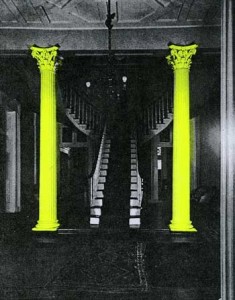 History often seems to bear out the overriding influence of architecture on art, not the other way around. Our built environments help determine what kind of artistic creations can be made to furnish them, and influence both the context and the quality of these furnishings at any given time. Architecture can highlight whatever is in-sync with the space it creates, but also has the ability to injure, chafe or cause abrasive friction to whatever it houses, or supports.
History often seems to bear out the overriding influence of architecture on art, not the other way around. Our built environments help determine what kind of artistic creations can be made to furnish them, and influence both the context and the quality of these furnishings at any given time. Architecture can highlight whatever is in-sync with the space it creates, but also has the ability to injure, chafe or cause abrasive friction to whatever it houses, or supports.
The architectural column—the most recognizable detail of Classical Greco-Roman building—is today, in 2008, a fragmented and ghostly symbol for largely codified ideas relating to Antiquity, Western Civilisation, Sigmund Freud and Greek Mythology. For The Scab of Antiquity, Samuel Rudolph revisits this iconographic emblem of “Civilisation” with an assembly of numerous constructed columns that disclose a sense of striving towards—or perhaps more appropriately, groping towards—the notions of beauty and order these structures typically represent. In Rudolph’s investigation, the icon of the Classical Order is rehabbed, its scab picked, to provide a sculptural dialogue between ideas of art and architecture, authenticity and artifice, as well as order and disorder. Slathering his columns with colour and texture, the artist reveals a keen sensitivity to the materiality of his sculptures and their latent connotative charge; his columns become loaded with a soul-soothing patch-work of optimism often associated with radical subcultures. While the scab is a rough affixation, it owns a certain organic beauty. As this exhibition intimates, the scab of history remains a lingering itch that that can’t easily be scratched off, something that—with some careful prodding—can nonetheless provide creative and conceptual fuel to re-envision the ways in which the past continues to mark the present.
Samuel Rudolph is a practicing LPN (a nurse) who is pursuing an art education at Emily Carr Institute. He reads cultural theory with vigour, watches YouTube a lot, and spends countless hours analyzing dead baby jokes.
